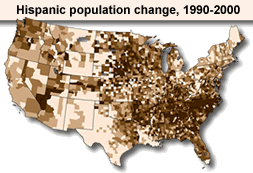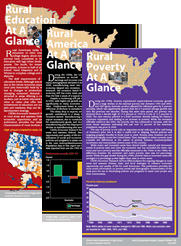overview
 Rural America is home to a fifth of the Nation's people, keeper of natural
amenities and national treasures, and safeguard of a unique part of American
culture, tradition, and history. Today, rural America comprises over 2,000
counties, contains 75 percent of the Nation's land, and includes 49
million
people. ERS research explores how investments in rural people, businesses,
and communities affect the capacity of rural economies to prosper in the
new and changing global marketplace. Equally important is our commitment
to enhancing the quality of life for the Nation's small farmers who are
increasingly dependent on these rural economies for their employment and
economic support. More overview...
Rural America is home to a fifth of the Nation's people, keeper of natural
amenities and national treasures, and safeguard of a unique part of American
culture, tradition, and history. Today, rural America comprises over 2,000
counties, contains 75 percent of the Nation's land, and includes 49
million
people. ERS research explores how investments in rural people, businesses,
and communities affect the capacity of rural economies to prosper in the
new and changing global marketplace. Equally important is our commitment
to enhancing the quality of life for the Nation's small farmers who are
increasingly dependent on these rural economies for their employment and
economic support. More overview...
related briefing rooms
 features features
New Patterns of Hispanic Settlement in Rural America—Since 1980, the nonmetro Hispanic population in the United States has doubled and is now the most rapidly growing demographic group in rural and small-town America. Many Hispanics in counties that have experienced rapid Hispanic growth are
recent U.S. arrivals with relatively low education levels, weak English
proficiency, and undocumented status. This ERS report compares socioeconomic indicators for Hispanics living in traditional and new rural destinations and documents the growing residential separation between Hispanics and non-Hispanic Whites during the 1990s, a period when Hispanic population dispersion increased significantly throughout nonmetro counties in all U.S. regions. See also the related Amber Waves article, Rural Hispanics: Employment and Residential Trends.
 Rural Poverty At A Glance—This publication provides the most recent information on poverty trends and demographic characteristics of the rural poor.
The rate of poverty is not only an important social indicator of the well-being of the least well off, but it is also widely used as an input in shaping Federal policies and targeting program benefits.
While metro and nonmetro areas have shared similar patterns of reductions and increases in poverty rates over time, there continues to exist a wide and persistent gap between nonmetro and metro poverty rates. The report also documents large metro-nonmetro gaps when poverty is analyzed by race, ethnicity, age, and family structure. Other reports in this series look at rural education and rural America (see all At A Glance reports).
Rural Poverty At A Glance—This publication provides the most recent information on poverty trends and demographic characteristics of the rural poor.
The rate of poverty is not only an important social indicator of the well-being of the least well off, but it is also widely used as an input in shaping Federal policies and targeting program benefits.
While metro and nonmetro areas have shared similar patterns of reductions and increases in poverty rates over time, there continues to exist a wide and persistent gap between nonmetro and metro poverty rates. The report also documents large metro-nonmetro gaps when poverty is analyzed by race, ethnicity, age, and family structure. Other reports in this series look at rural education and rural America (see all At A Glance reports).
Workshop on Agricultural and Food Cooperatives
in Rural America—Both local
and national governments have a strong interest and long history in fostering
business growth to generate jobs, to add to the tax base, and to enhance
the local quality of life. In rural areas especially, some of these programs
and policies are aimed at businesses organized as cooperatives. In recent
decades, however, the number of cooperatives has declined and several
large, well-known cooperatives have failed. This workshop
explored the determinants of success and failure of cooperatives and the
implications for public policy. The workshop was held at
ERS on June 16 and 17, 2004. An agenda is
available.
 Workshop
on Agricultural Policy Links to Farm Households and the Rural Economy—Farm
programs have an impact on farm households and rural communities
as well as agricultural commodity markets. To
address this important policy area, the National Center for Food
and Agricultural Policy (NCFAP) and the Economic Research Service
(ERS) held a workshop on May 14, 2004, to broaden the information
base available to decision makers. The aim of the workshop was to
go beyond traditional considerations and begin to address farm policy's
intended and unintended consequences for farm households and rural
America well in advance of the next farm bill. Abstracts of presentations are available on the National Center for Food and Agricultural Policy website. Workshop
on Agricultural Policy Links to Farm Households and the Rural Economy—Farm
programs have an impact on farm households and rural communities
as well as agricultural commodity markets. To
address this important policy area, the National Center for Food
and Agricultural Policy (NCFAP) and the Economic Research Service
(ERS) held a workshop on May 14, 2004, to broaden the information
base available to decision makers. The aim of the workshop was to
go beyond traditional considerations and begin to address farm policy's
intended and unintended consequences for farm households and rural
America well in advance of the next farm bill. Abstracts of presentations are available on the National Center for Food and Agricultural Policy website.
recommended readings
Anatomy of Nonmetro High-Poverty Areas: Common in Plight, Distinctive in Nature—For the most part, nonmetro areas of high poverty are of long standing, with conditions stemming from a complex of social and economic factors. This Amber Waves article identifies a typology of high-poverty counties that reflect racial/ethnic and regional differences in major characteristics such as education, employment, family structure, incidence of disability, and language proficiency that are relevant to programs of poverty alleviation. Of the more than 400 nonmetro counties classified as high-poverty counties in 2000 (based on 1999 income), three-fourths reflect the low income of racial and ethnic minorities and are classified as Black, Native American, or Hispanic high-poverty counties. The remaining quarter of high-poverty counties are mostly located in the Southern Highlands, and the poor are predominantly non-Hispanic Whites. See also the chapter on high-poverty counties for more information and lists of these counties.
 Rural
Dimensions of Welfare Reform—The Personal Responsibility and
Work Opportunity Reconciliation Act (PRWORA) dramatically altered the
social safety net for poor Americans. But there is reason to believe
that welfare reform outcomes may be different for many of the 7.5 million
people living in poverty in rural areas. This book presents the first
comprehensive analysis of PRWORA's impact on caseloads, employment,
earnings, and food assistance in rural areas. It is the result of a
conference—held in May of 2000—that was jointly sponsored
by the Economic Research Service, the Joint Center for Poverty Research,
and the Rural Policy Research Institute, and funded by ERS's Food and
Nutrition Research Program. More information is available at W.E.
Upjohn Institute for Employment Research. Rural
Dimensions of Welfare Reform—The Personal Responsibility and
Work Opportunity Reconciliation Act (PRWORA) dramatically altered the
social safety net for poor Americans. But there is reason to believe
that welfare reform outcomes may be different for many of the 7.5 million
people living in poverty in rural areas. This book presents the first
comprehensive analysis of PRWORA's impact on caseloads, employment,
earnings, and food assistance in rural areas. It is the result of a
conference—held in May of 2000—that was jointly sponsored
by the Economic Research Service, the Joint Center for Poverty Research,
and the Rural Policy Research Institute, and funded by ERS's Food and
Nutrition Research Program. More information is available at W.E.
Upjohn Institute for Employment Research.
Impacts of Hispanic Population Growth on Rural
Wages—The number of Hispanics in rural areas grew by 70 percent
between 1990 and 2000. Is the rapid influx of large numbers of Hispanics
depressing local wages or are Hispanics filling a need for labor that is
not present in the receiving communities? This report examines the impact
of Hispanic population growth on rural wages during the 1990s, concluding
that Hispanic population growth led to lower wages for at least one segment
of the rural population—workers with a high school degree (skilled workers).
See all recommended readings...
recommended data products
2004 County Typology Codes—An area's economic and social characteristics have significant effects on its
development and need for various types of public programs. ERS has developed a new set of county-level
typology codes that captures differences in economic and social characteristics.
The six nonoverlapping economic types
are farming-dependent, mining-dependent, manufacturing-dependent, Federal/State government-dependent,
services-dependent, and nonspecialized. Also, counties are classified
based on seven overlapping policy types: housing stress, low-education, low-employment, population loss, persistent poverty, nonmetro recreation, and retirement destination counties. See the typology code chapter in the measuring rurality briefing room for more information, links to maps, and methodolgy.
2003 Urban Influence Codes—These codes form a classification scheme
that distinguishes metropolitan counties by size and nonmetropolitan
counties
by size of
the largest city or town and proximity to metro and micro areas. The
standard Office of Management and Budget (OMB) metro and nonmetro categories
have been subdivided into two metro and 10 nonmetro categories, resulting
in a 12-part county codification. This scheme was originally developed
in 1993. This scheme allows researchers to break county data into finer
residential groups, beyond metro and nonmetro, particularly for the analysis
of trends in nonmetro areas that are related to population density and
metro influence.
2003 Rural-Urban Continuum Codes—The
2003 Rural-Urban Continuum Codes form a classification scheme that distinguishes
metropolitan counties by size and nonmetropolitan counties by degree of
urbanization and proximity to metro areas. The standard Office of Management
and Budget (OMB) metro and nonmetro categories have been subdivided into
three metro and six nonmetro categories, resulting in a 9-part county
codification. This scheme allows researchers to break county data into
finer residential groups, beyond metro and nonmetro, particularly for
the analysis of trends in nonmetro areas that are related to population
density and metro influence.
State Fact Sheets—contains information
on population, per-capita income, earnings per job, poverty rate, total
number of jobs, unemployment rate, percent employment change, farm and
farm-related jobs, top export commodities, farm characteristics, and farm
financial indicators.
See all recommended data products...
recent research developments
Comparisons of Metropolitan-Nonmetropolitan
Poverty During the 1990s—It's well established that the incidence
of nonmetro poverty is greater than metro poverty, but there is little
research as to whether poverty is deeper or more severe in nonmetro areas.
The research report provides a closer look at the incidence, depth and
severity of poverty in nonmetro and metro areas and the implications of
these findings for Federal welfare policies.
Income, Wealth, and the Economic Well-Being
of Farm Households—This report examines factors that affect
the economic well-being of farm operator households based on USDA's
ARMS data. The analysis uses a new concept of economic well-being
that captures farm household wealth and expenditures in addition to
more conventional income measures. The report examines whether farm
households are inherently disadvantaged and whether they have lower
incomes, lower wealth, and lower household expenditures than nonfarm
households.
Agricultural
Income and Finance Situation and Outlook—This periodical
provides historical estimates and forecasts of farm sector financial
information that gauge the financial health of the Nation's farmers
and ranchers. Common topics include trends in farm sector receipts,
expenses, debt, assets, and costs of producing crops and livestock.
Each issue concentrates on a particular area of the farm financial
picture.
related links
USDA Rural Development—This site provides
information on USDA business, housing, and utility programs to improve
the economy and quality of life in rural America.
Small Farms@USDA—This is a gateway to resources, benefits, and services offered by USDA for small farmers, including the Small Farms Advisory Commission's recommendations and USDA action plans.
See all related links...
maps and images gallery
Rural Gallery—Charts and maps depict
information on rural indicators, including population
and migration; labor and education; income, poverty, and welfare; housing; and
industry.
for more information, contact:
Leslie Whitener
web administration: webadmin@ers.usda.gov
page updated: September 27, 2004
|
 Also at ERS...
Also at ERS... |
|
|
|
 Rural America is home to a fifth of the Nation's people, keeper of natural
amenities and national treasures, and safeguard of a unique part of American
culture, tradition, and history. Today, rural America comprises over 2,000
counties, contains 75 percent of the Nation's land, and includes 49
million
people. ERS research explores how investments in rural people, businesses,
and communities affect the capacity of rural economies to prosper in the
new and changing global marketplace. Equally important is our commitment
to enhancing the quality of life for the Nation's small farmers who are
increasingly dependent on these rural economies for their employment and
economic support. More overview...
Rural America is home to a fifth of the Nation's people, keeper of natural
amenities and national treasures, and safeguard of a unique part of American
culture, tradition, and history. Today, rural America comprises over 2,000
counties, contains 75 percent of the Nation's land, and includes 49
million
people. ERS research explores how investments in rural people, businesses,
and communities affect the capacity of rural economies to prosper in the
new and changing global marketplace. Equally important is our commitment
to enhancing the quality of life for the Nation's small farmers who are
increasingly dependent on these rural economies for their employment and
economic support. More overview...



 Rural
Dimensions of Welfare Reform
Rural
Dimensions of Welfare Reform